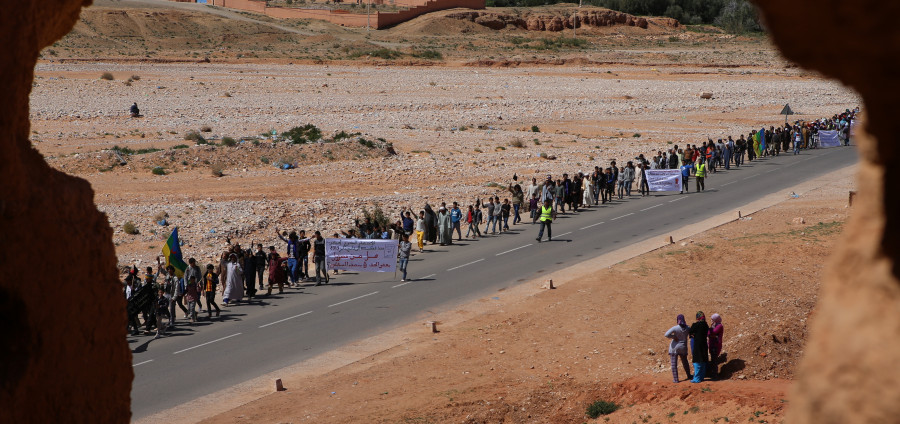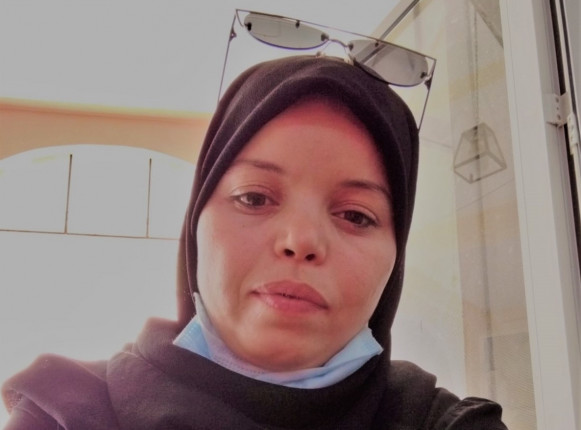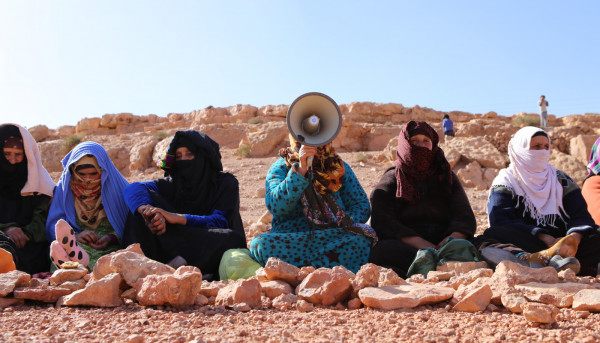Interview with activist and 'Amussu' producer Naima Ouchtoubane
18th August 2021

Co-curators Finn Daniels-Yeomans and Carmen Thompson interview Naima OUCHTOUBANE about documentary Amussu, a collaborative film project about the protest movement in Imider, Morocco, whose villagers are resisting one of Africa’s biggest silver mines to save their oasis. Naima is 27 years old, with a bachelor degree in sociology. She is an activist of the Imider protest movement and works with Imider women in a literacy program.
The following interview was translated by Mohamed ED DAOUDY. It includes the original Arabic.
 Q. To begin, we know that you have been actively involved in the Imider protest movement and have also studied it. Are you able to provide a broader context of this peaceful movement: When was it established? What were the reasons for its establishment? And what have been its central aims and ambitions?
Q. To begin, we know that you have been actively involved in the Imider protest movement and have also studied it. Are you able to provide a broader context of this peaceful movement: When was it established? What were the reasons for its establishment? And what have been its central aims and ambitions?
A. The “Movement on the road’96” is an independent, grassroots protest movement, founded on August 1st of 2011, as it came as a natural response to many sufferings experienced by the residents of the Imider community, which hosts one of the largest silver mine in the world, and the residents don’t benefit from it at all, but the overexploitation of the underground water and the pollution resulting from mining activities, as the silver purification process requires the use of chemicals that are dangerous to the environment and to the life of the human being, such as Cyanide...,
There are also other motives, which are manifested in:
- A severe shortage of potable water, the agriculture is damaged, and the harvest of irrigated crops along the oasis decreases year after year.
- The emergence of several chronic diseases, as the cause is mainly attributed to the pollution emanating from the mining activity; Such as skin diseases and allergies (Eczema, Silicosis, Cancer...,).
- The community doesn’t benefit at least from job opportunities in the mine.
- There are also historical extensions linked to the collective memory of the residents of Imider, such as the residents' protests against the silver mine in 1986, 1996, and 2004.
- The increase and accumulation of the damages caused by the mine results the explosion of the social climate, and thus the birth of the Imider protest movement as a popular action that seeks to change the situation.
كبداية، نعرف أنك منخرطة نشطة في حركة إميضر الاحتجاجية، كما قمت بدراستها كذلك، هل بإمكانك تقديم سياق أوسع لهده الحركة السلمية: متى تأسست؟ ما هي دواعي تأسيسها؟ وما هي أهدافها الأساسية وطموحاتها؟
"حركة على درب 96" حركة احتجاجية راديكالية مستقلة، تأسست في فاتح غشت من سنة 2011، كما جاءت كرد فعل طبيعي على إثر مجموعة من المعاناة التي تعاني منها ساكنة جماعة إميضر التي تحتضن واحدا من أكبر مناجم الفضة في العالم، ولم تستفد منه الساكنة سوى استنزاف الفرشة المائية والتلوث الناتج عن الأنشطة المعدنية، حيث تتطلب تصفية الفضة استعمال مواد كيماوية خطيرة على البيئة وعلى حياة الإنسان الاميضري مثل السيناتور...،
كما هناك دوافع أخرى وتتجلى في:
معاناة الساكنة من نقص حاد للماء الصالح للشرب طيلة أعوام من الاستغلال المنجمي للمياه، كما تضررت الفلاحة وضعف إنتاج الزراعات المسقية على طول الواحة.
ظهور عدة أمراض مزمنة، بحيث يعزى السبب إلى التلوث الصادر من المنجم؛ كالأمراض الجلدية و الحساسية ( الكزيما الدقة، السيلكوز، السرطان ...،).
عدم استفادة الساكنة من فرص الشغل المتوفرة بالمنجم .
كما أن هناك امتدادات تاريخية مرتبطة بالذاكرة الجماعية لسكان إميضر، من قبيل احتجاجات الساكنة ضد شركة معادن إميضر سنوات 1986، 1996،2004،2011.
بعد ارتفاع وتراكم حجم الأضرار التي سببها المنجم، نجم عنه انفجار الوضع الاجتماعي المحتقن، وبالتالي ميلاد حركة على درب 96 كإطار شعبي يسعى إلى تغيير الأوضاع.
Q. We understand that your mother and brother are both activists involved in the Imider protests. What has that been like? What are your personal experiences of the protests from the ground?
A. My mother, my brother and the rest of my family have also participated alongside the residents in the movement protests, in order to stop the damages caused by the overexploitation and the looting of water resources, lands and sands, by the Société métallurgique d’Imider SMI. This protest faced a wave of arrests from the beginning. My brother Mustafa was the first to be arrested accused of many charges, most notably “inciting on disobedience”. He was arrested on October 10, 2011 and sentenced to four years.
I participated in all the activities of the protest movement; with my presence, my interactions, my suggestions, and my voice. I participated in the production of the documentary Amussu, and also studied our movement as a student and researcher in sociology, as part of my thesis to obtain my bachelor degree.
نفهم أن والدتك وأخاك ناشطين منخرطين في احتجاجات إميضر. كيف كان ذلك؟ ما هي تجاربك الشخصية في الاحتجاج من القاعدة؟
شاركت أمي وأخي وباقي أفراد أسرتي أيضا إلى جانب الساكنة في احتجاجات حركة على درب 96، من أجل رفع الضرر الناتج عن استغلال ونهب الموارد المائية، الأراضي والرمال، من طرف شركة معادن إميضر. هدا الاحتجاج قوبل مند البداية بموجة من الاعتقالات، فكان أخي مصطفى أوّل المعتقلين، بتهم كثيرة أبرزها التحريض على العصيان، تم اعتقاله يوم 10 أكتوبر 2011 والحكم عليه بأربعة سنوات نافدة.
لقد شاركت في جميع أنشطة الحركة الاحتجاجية بحضوري وتفاعلاتي ومقترحاتي، وصوتي. شاركت في إنتاج فيلم أموسو الوثائقي، كما اشتغلت على دراسة حركتنا كطالبة باحثة في السوسيولوجيا، في إطار بحث نهاية الدراسة لنيل الإجازة.
Q. A theme that we are exploring through the films in our programme is women’s work, referring to labour of all kinds (activism, filmmaking, care-work, etc). Can you tell us about the work of women in the Imider movement?
A. The participation of women in the Imider protest movement is evident ; in their impact presence in the direct protest actions from the beginning, as they’re the first affected by the impacts of pollution and drought. The aspect of preparing food for the protesters in our permanent protest camp, and other roles...,
من خلال الأفلام، يسعى برنامجنا إلى اكتشاف موضوع عمل النساء، علاقة مع مختلف الأعمال (النضال، صناعة الافلام، أعمال الرعاية، إلخ). هل بإمكانك الحديث عن عمل النساء في إطار حركة إميضر؟
تتجلى مشاركة النساء في حركة على درب 96 في حضورها الوازن في الاحتجاج المباشر مند البداية، كونها المتأثرة الأولى من انعكاسات التلوث والجفاف، فساهمن بآرائهن حول كل النقاط التي تناقش في "أكراو" (الجمع العام)، وشاركن في تنظيم المسيرات والأنشطة الربيعية للحركة، إلى جانب إعداد الطعام للمحتجين في المعتصم، وغيرها من الأدوار...،
Q. Amussu is made within a bottom up, collectivist method inspired by the revolutionary principles of Third Cinema and the indigenous Amazigh models of autonomous and democratic governance. Can you tell us about your experience of working in this participatory filmmaking process?
A. This participatory method which we worked with while producing Amussu documentary was not limited to this latter, rather, it is a principle that characterizes our movement in all its activities. I participated in the film production workshops and the discussions accompanying this process. I also participated in one of the film images as a character, the one in which I was giving a talk in the Agraw (the general assembly of protesters), where I provided many clarifications about the difference between a protest act and the political one, and mentioning the fact that the state institutions don’t respect the laws it proves. Amussu’s experience was also unique, as all groups (children, women, men...) have participated in its production. I consider this experience a rebellion against hall cinema and the film industry in its known mode currently.
تم إنتاج أموسّو من القاعدة (التحت)، بطريقة جماعية مستوحاة من المبادئ الثورية للسينما الثالثة والنماذج الامازيغية الأصلية للاستقلالية والحكامة الديمقراطية. هل بإمكانك الحديث عن تجربة مشاركتك ضمن صيرورة هذا الإنتاج السينمائي التشاركي ؟
هذا النموذج التشاركي الذي اشتغلنا به خلال تجربة إنتاج فيلم أموسو لم يقتصر فقط على هدا الاخير، بل هو مبدأ يميز حركتنا في كل أنشطتها، لقد شاركت في ورشات إنتاج الفيلم والنقاشات المواكبة لهده الصيرورة، وشاركت أيضا في إحدى لقطات الفيلم، التي كانت عبارة عن مداخلة لي في اكراو (الجمع العام للمحتجين)، حيث قدمت العديد من التوضيحات حول علاقة الفعل الاحتجاجي بالسياسي، وأثرت مشكلة عدم التزام مؤسسات الدولة بالقوانين التي تصادق عليها.
كما كانت تجربة أموسو فريدة من نوعها، حيث شاركت في إنتاجه كل الفئات (أطفال، نساء، رجال...)، أعتبر هده التجربة تمردا على سينما القاعات وصناعة السينما.
 Q. There is a moment in Amussu when one of the protesters proclaims that ‘cinema can be a tool in the hands of the people’. What do you think the role of the Amussu, and cinema more generally, has performed in supporting the Imider community and in furthering its struggle for social and environmental justice?
Q. There is a moment in Amussu when one of the protesters proclaims that ‘cinema can be a tool in the hands of the people’. What do you think the role of the Amussu, and cinema more generally, has performed in supporting the Imider community and in furthering its struggle for social and environmental justice?
A. The role of the Amussu documentary is to present the Imider cause and its protests, to share our story with the public opinion, in the national and the international level. Although it is a film that tells about the experience of our protests and resistance, we consider its production itself a form of resistance. In addition to the educational value it performs on the topic of local indigenous good practices linked to natural resources and nature in general.
في لحظة ما من فيلم أموسّو، يقول أحد المحتجّين 'إن السينما يمكن أن تكون أداة في يد الشعب'، كيف ترين دور فيلم أموسّو، والسينما بشكل عام، في أدائها لدعم ساكنة إميضر وتعزيز نضالها من أجل العدالة البيئية والاجتماعية؟
دور فيلم أموسو هو التعريف بقضية إميضر واحتجاجاتهم، ومشاركة قصة ساكنة إميضر مع الرأي العام. رغم كونه فيلما يحكي عن تجربة احتجاجاتنا ومقاومتنا، إلا أننا نعتبر إنتاجه شكلا من أشكال المقاومة بحد ذاته. أضف إلى دلك القيمة التربوية التي يؤديها حول موضوع الممارسات الأصلية المحلية المتعلقة بالموارد الطبيعة والطبيعة بشكل عام.
Q. And, finally, Amussu is screening as part of a programme aligned with COP26, the United Nations climate change summit taking place in Glasgow in November 2021. Is there anything that you would say to the summit’s members? Is there anything that you think should be top of the agenda?
A. In relation to the COP26 Climate Summit, I would like to show the importance of the Imider cause model in dealing with climate changes; negotiations must not be limited to the issue of global warming and work to reduce greenhouse gases, as they must also include procedural plans that will protect ecosystems and social systems that enhances resistance to the impacts of climate changes. The best example of this is the oasis system, traditional irrigation systems, and other local indigenous knowledge, which mines are destroying, in Imider for example, and this applies to other indigenous communities around the world.
وأخيرا، سيتم عرض أموسّو كجزء من برنامج موازي لمؤتمر قمة المناخ COP26، التي ستجري بكلاسكو شهر نونبر 2021. هل لديك ما تودّين قوله لأعضاء القمة؟ هل هناك ما تعتقدين أنه يستحق التواجد على رأس جدول الأعمال؟
علاقة بمؤتمر قمة المناخ COP26 ، أود أن أثير أهمية نمودج قضية اميضر في التعامل مع التغيرات المناخية، المفاوضات لا يجب أن تقتصر فقط على موضوع الاحتباس الحراري والعمل على الخفض من الغازات الدفيئة، بقدر ما يجب أن تشمل أيضا المخططات الإجرائية التي من شأنها حماية الأنظمة الايكولوجية والاجتماعية التي تعزز مقاومة انعكاسات التغيرات المناخية. وأفضل مثال على ذلك، النظام الواحي، أنظمة الري التقليدية، وغيرها من المعارف الأصلية المحلية، والتي تدمرها المناجم في حال إميضركمثال، هدا ينطبق على باقي المجتمعات الأصلية حول العالم.
Amussu is screening online on Saturday 21 August as part of our programme We Get Shot With Silent Bullets (20-22 August). It will be available to watch for 48 hours.
The programme is hosted in partnership with EDI Lab at University of Glasgow’s College of Arts, as part of their The Dear Green Bothy event series marking the city’s hosting of the 26th United Nations Climate Change Conference –COP26 – in November 2021.
